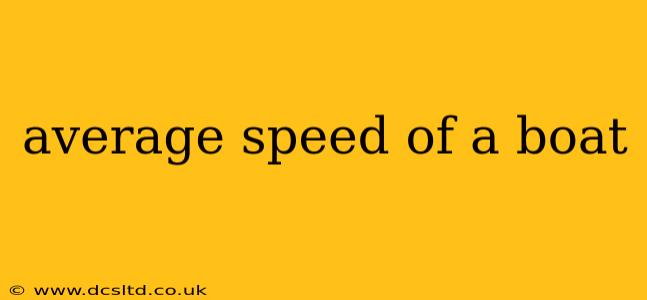Determining the "average speed of a boat" is tricky because it's not a single, universally applicable number. Unlike a car with a speedometer constantly displaying its speed, a boat's speed is highly variable, influenced by numerous factors. This article delves into the complexities of boat speed, exploring the key elements that affect it and providing methods for calculating average speed in different scenarios.
What Factors Influence a Boat's Speed?
Several factors significantly impact a boat's speed, making a single "average" difficult to pinpoint. These include:
- Hull Design: The shape of the boat's hull plays a crucial role. A sleek, hydrodynamic hull designed for speed will naturally move faster than a broader, flatter hull designed for stability or cargo.
- Boat Type: Different boat types (sailboats, motorboats, kayaks, etc.) have vastly different speed capabilities. A racing sailboat will be much faster than a fishing trawler.
- Engine Power (for motorboats): The horsepower of the engine directly correlates to the boat's potential speed. More powerful engines generally mean faster speeds.
- Weight: The boat's weight, including passengers, cargo, and fuel, significantly impacts speed. A heavier load reduces speed.
- Water Conditions: This is perhaps the most variable factor. Calm water allows for maximum speed, while waves, currents, and wind can drastically reduce speed or even impede progress. Headwinds are particularly challenging.
- Propeller Efficiency: The design and condition of the propeller impact how effectively the engine's power translates into forward motion.
- Draft: The depth of the hull below the waterline affects speed, especially in shallow water where the hull may drag.
How Do You Calculate a Boat's Average Speed?
Calculating average speed for a boat requires knowing the total distance traveled and the total time taken. The formula is straightforward:
Average Speed = Total Distance / Total Time
For example, if a boat travels 20 nautical miles in 2 hours, its average speed is 10 knots (nautical miles per hour).
However, accurately calculating average speed requires considering the variability caused by changing water conditions. You might need to break the journey into segments with more consistent speed and then calculate the average for each segment.
What is the Average Speed of Different Types of Boats?
Providing exact average speeds is misleading due to the above factors. However, we can offer general ranges:
- Small Motorboats: May average 10-25 knots depending on the engine size, load, and water conditions.
- Sailboats: Average speed depends heavily on wind conditions. Under ideal conditions, some sailboats can reach 10-15 knots, but average speeds are often much lower.
- Kayaks/Canoes: These typically average speeds under 5 knots, strongly influenced by paddling effort and water conditions.
- Large Cruise Ships: These generally have lower average speeds, in the range of 15-25 knots.
How is Boat Speed Measured?
Boat speed is typically measured using a speedometer integrated into the boat's instrumentation, often linked to a GPS for more accurate readings. Older boats may use a pitot tube system, measuring the water pressure to estimate speed.
What are the factors affecting the speed of a boat in the water?
This question has been addressed extensively in the section "What Factors Influence a Boat's Speed?" above.
What is the average speed of a small motorboat?
As discussed earlier, the average speed of a small motorboat is highly variable. A reasonable estimate, under favorable conditions, would be within the range of 10-25 knots. However, factors such as engine size, boat load, and water conditions will significantly affect this.
What is the fastest boat in the world?
Determining the absolute fastest boat is challenging as speed records are constantly being broken and different categories of boats (like hydrofoils) are compared. To get the most up-to-date information, it's best to consult current boating news and records.
In conclusion, while a simple average speed for a boat is hard to define, understanding the influencing factors and using the proper calculation methods allows for a more accurate assessment in specific scenarios. Remember to always prioritize safety and check local regulations when operating a boat.
